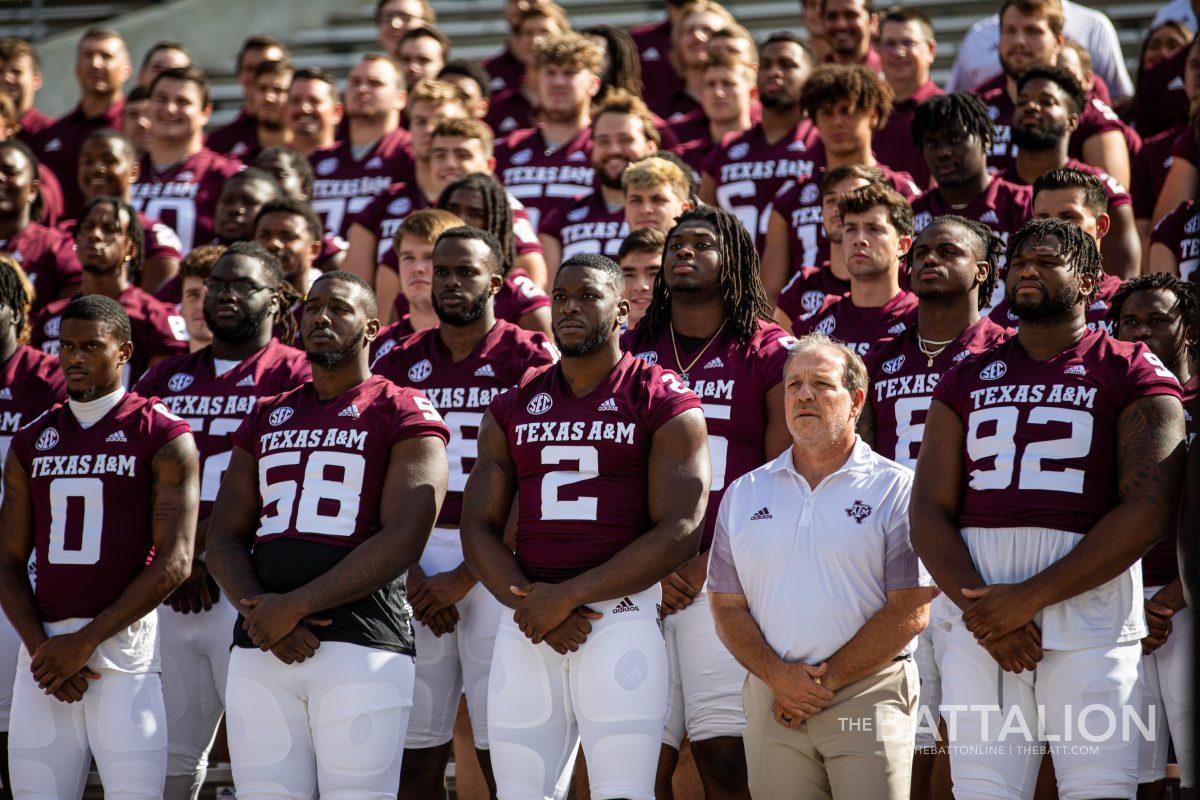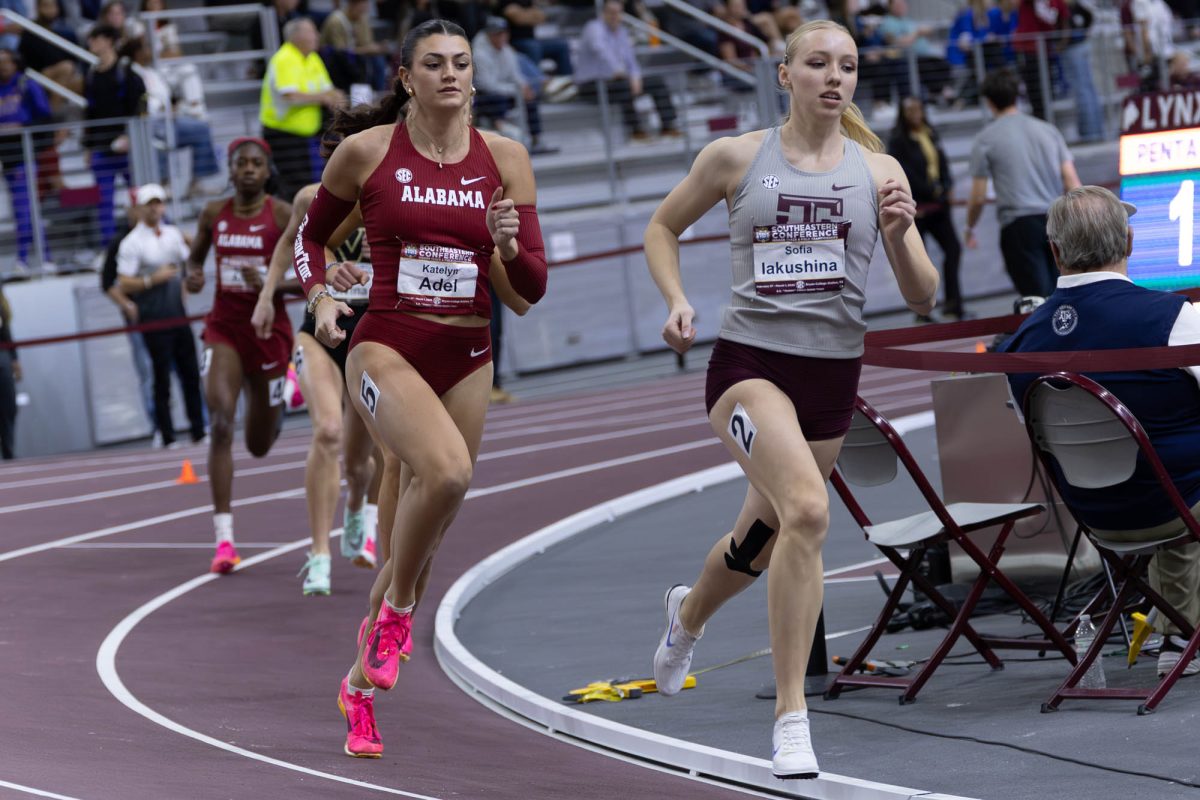Within the realm of college athletics, Texas A&M is held back by its failures in the field of diversity, equity and inclusion, or DEI.
As of presstime, A&M endorses 16 NCAA Division I athletic teams. Of those, all are led by a white head coach. No person of color has served in such a role since Kevin Sumlin left A&M in 2017, reviving a period of marked racial inequality in the 12th Man Athletics program. To compound the issue, only three of the current head coaches identify as women — equestrian’s Tana McKay, softball’s Jo Evans and volleyball’s Laura “Bird” Kuhn — even though 10 different teams include women athletes, and eight teams’ rosters are entirely women.
This widening rift has caught the attention of others outside the maroon and white’s sports teams, including John Singer, Ph.D., an associate professor of sport management at A&M studying diversity in athletics. Having first become fascinated with race and its relationship to collegiate sports while studying as a graduate student at a predominantly white university, Singer said A&M’s lack of diversity in coaching positions is reflective of a nationwide trend.
“We can’t have this conversation without understanding the nuance,” Singer said. “There’s factors at the more broad, systemic level, the organizational level and the individual level.”
According to The Washington Post, Black students alone make up over 60 percent of all collegiate football and basketball rosters across the nation. Hispanic and Latinx students make up another 12 percent of athletes across all sports.
Competing on A&M’s nationally acclaimed soccer team as a “proud Black woman,” senior defender Karlina Sample said she experiences firsthand the influence non-white athletes can hold within a championship-contending program. This is why including diversity within a team’s coaching staff should be an emphasis, she said.
“A lot of the athletes are people of color, so they need to be represented,” Sample said.
Singer added that athletic staffs should be held accountable for making hiring decisions which fail to reflect similar backgrounds of the athletes themselves.
“When you look at some sports, we see a high representation of racial minority students,” Singer said. “There’s really no excuse not to make [hiring coaches of color] a priority.”
A&M’s Department of Athletics established a Diversity and Inclusion program to help bridge the gap between 12th Man Athletics and the needs of athletes of color. According to its website, the project was created to “provide a safe, healthy, equitable, respectful, inclusive and supportive environment” which allows all athletes to “thrive.”
This included the creation of The Aggie Commitment initiative, The B.L.U.E.print program and the Unified Voices platform.
As both the deputy athletics director and chief diversity officer for 12th Man, Kristen Brown played a critical role in the implementation of these steps toward progress. Because she has 18 years of experience working as a Black woman in the sports industry, Brown — the athletic department’s highest-ranking woman administrator — said she has pushed the department to prioritize DEI policies on a daily basis.
“Our goal is to develop and implement plans and strategies to increase equity and maintain an environment of inclusiveness,” Brown said. “Then through that, we focus on unity, education and engagement.”
To some, however, these steps by the school administration are not enough. Sample, president of The B.L.U.E.print, or Black Leaders who Undertake Excellence, organization, said she felt a calling as a leader to push for representation and change not supplied by the university.
This does not focus only on athletics, Sample said, instead emphasizing the importance of growth in all aspects of an athlete’s life.
“We remind athletes that they’re so much more than just an athlete for the sport they play. They have so much more substance,” Sample said. “[The organization] tries to elevate student athletes and lift them up in terms of academics, careers and other resources outside of sports. It represents growing as a person and as an individual.”
Brown said the work of young adults like Sample on campus have helped advance A&M toward progress in areas in which even the Diversity and Inclusion program has fallen short.
“[The B.L.U.E.print] has been an incredible organization where we’ve had so many student athletes who have stepped up in leadership roles, not just within their teams, but across the entire department,” Brown said.
But this fight for representation is not a war the athletes should wage on their own, Singer said. When it comes to keeping people of color out of head coaching positions, Singer said a variety of factors often worsen the situation: implicit and explicit biases, a supposed lack of hiring candidates or a lack of thoroughness and intentionality when hiring.
However, none of these reasons are valid excuses to pardon the lack of diversity among A&M’s head coaches, Singer said.
“If [hiring managers] have the will, skill and knowledge to get athletes of color here, then they should have the will, skill and knowledge to recruit coaches who reflect that,” Singer said. “People have a certain bias toward people who look like them, think like them and have similar experiences. So, if an athletic director or hiring manager lacks those experiences, it can be subconsciously reflected in a coaching staff.”
Brown said the athletics department is aware of the issue and takes full responsibility for the situation.
“That fact is not lost on administration,” Brown said. “That responsibility lies on us as athletics department leadership to make sure that we are being intentional and inclusive in our hiring practices and making sure that we are seeking out every possible candidate for these positions.”
Moving forward, A&M must choose between two paths for the future. On one hand, the university can continue to admit there is an issue without implementing any real programs which attempt to solve the problem. Or, administrators can begin taking seriously the raised concerns of students, athletes and other faculty members to better serve a community which has more than doubled in size at A&M since 2003, Sample said.
Sample said it is her vision to see the university take the latter approach, providing more support and opportunities for advancement to other athletes of color. This is especially pronounced by the capacity in which athletes of color can and should play a role in the hiring process of a new head coach, Sample said.
“I would just encourage A&M to be more intentional about hiring more people of color,” Sample said. “I think that’s overlooked as if it’s not a big deal. And student athletes can be used as a vessel for improvement in that area.”
In line with the dream of the 2020 SEC Co-Defender of the Year, Brown said she hopes to use her position in the department to improve the overall culture and climate at A&M.
“It’s all about continuing growth and continuing to make sure that A&M is inclusive and that when you walk onto our campus — no matter if you are Black, white, Hispanic, Asian, male, female, however you identify — that you feel at home, you feel welcome and you feel comfortable being exactly who you are in the skin that you’re in,” Brown said.
So there is cause for hope at A&M, Sample said. Student-led initiatives show the commitment young Aggies hold for their university, and programs implemented by the university aim to work toward a more diverse and inclusive sphere of maroon and white athletics.
But at some point, the university must “step up” and do more than what is currently in the works, Singer said. This begins with hiring a coach of color to which athletes can look for leadership, guidance and promise of success.
“At the end of the day, you can have all the diversity programs, rhetoric or statements of commitment to diversity that you want,” Singer said. “But if you don’t have decision makers with the will and intentionality to change the demographics of a coaching staff, it’s not going to get done.”
A&M coaching lacks diversity
October 21, 2021
Photo by Photo by Abbey Santoro
Despite claims of increasing diversity, equity and inclusion in A&M athletics, all three head coaches hired in the last four months are white men.
0
Donate to The Battalion
$2790
$5000
Contributed
Our Goal
Your donation will support the student journalists of Texas A&M University - College Station. Your contribution will allow us to purchase equipment and cover our annual website hosting costs, in addition to paying freelance staffers for their work, travel costs for coverage and more!
More to Discover









